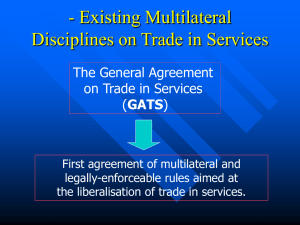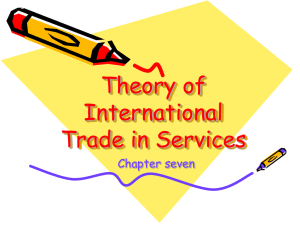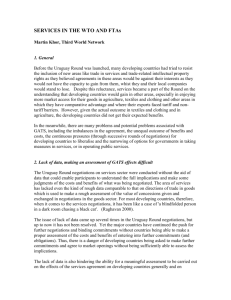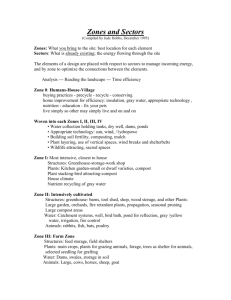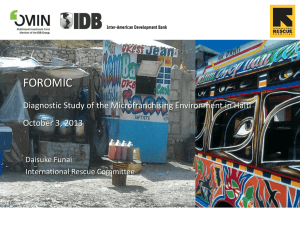basic development issues in the wto services negotiations
advertisement
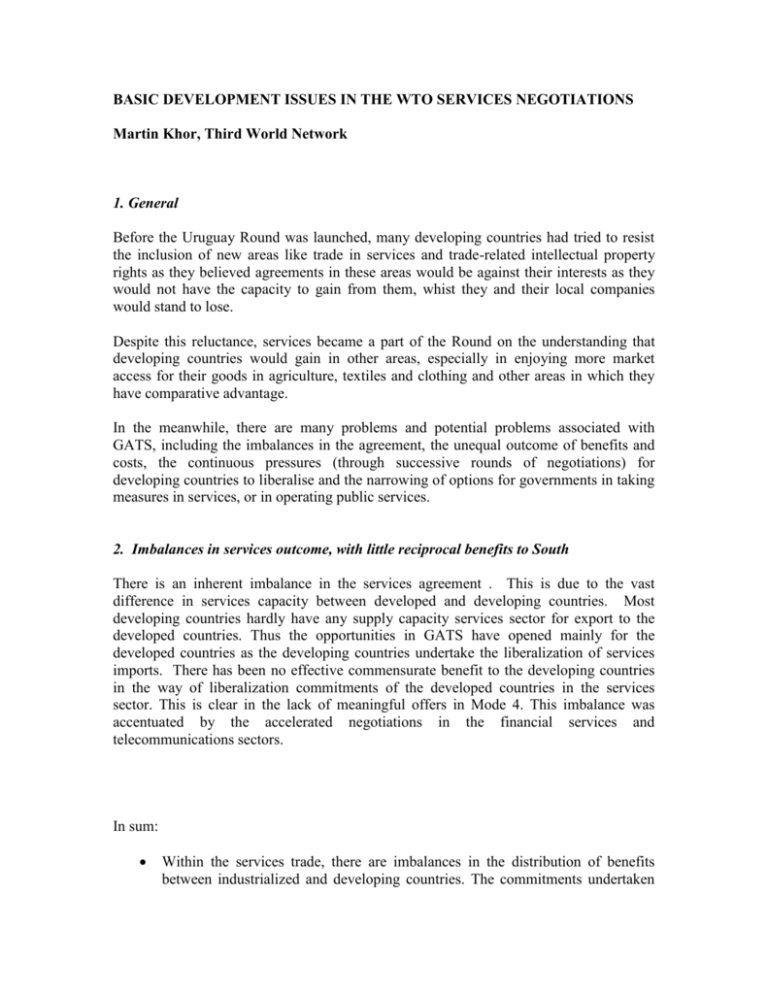
BASIC DEVELOPMENT ISSUES IN THE WTO SERVICES NEGOTIATIONS Martin Khor, Third World Network 1. General Before the Uruguay Round was launched, many developing countries had tried to resist the inclusion of new areas like trade in services and trade-related intellectual property rights as they believed agreements in these areas would be against their interests as they would not have the capacity to gain from them, whist they and their local companies would stand to lose. Despite this reluctance, services became a part of the Round on the understanding that developing countries would gain in other areas, especially in enjoying more market access for their goods in agriculture, textiles and clothing and other areas in which they have comparative advantage. In the meanwhile, there are many problems and potential problems associated with GATS, including the imbalances in the agreement, the unequal outcome of benefits and costs, the continuous pressures (through successive rounds of negotiations) for developing countries to liberalise and the narrowing of options for governments in taking measures in services, or in operating public services. 2. Imbalances in services outcome, with little reciprocal benefits to South There is an inherent imbalance in the services agreement . This is due to the vast difference in services capacity between developed and developing countries. Most developing countries hardly have any supply capacity services sector for export to the developed countries. Thus the opportunities in GATS have opened mainly for the developed countries as the developing countries undertake the liberalization of services imports. There has been no effective commensurate benefit to the developing countries in the way of liberalization commitments of the developed countries in the services sector. This is clear in the lack of meaningful offers in Mode 4. This imbalance was accentuated by the accelerated negotiations in the financial services and telecommunications sectors. In sum: Within the services trade, there are imbalances in the distribution of benefits between industrialized and developing countries. The commitments undertaken in GATS do not reflect the interests of developing countries in terms of commercially meaningful sectoral and modal coverage. Developing countries have not derived benefits through scheduled commitments from their industrialized-country partners in terms of Article IV and Article XIX of GATS (Mashayekhi 2000). Since the two sides have unequal capacities, therefore if the two sides are to be treated equally, there will be an unequal outcome. For example, if a developed and a developing country were to commit to liberalise Mode 3 in banking, theoretically each country’s banks can invest in the other; but in practice the banks of the developing country are too small to establish themselves in the developed country. However the developed country’s banks can overwhelm the local banks in the developing country. This is quite unlike the case of goods, where developing countries have more export possibilities, and there is greater likelihood of a balance in trade in goods. 3. Supply constraints and barriers to services exports of developing countries In the implementation of GATS, developing countries face structural problems hindering their ability to export services. As an UNCTAD study put it: "The efforts of developing countries to develop services as a major export item and contributor to development and to penetrate the world market for services have faced considerable barriers. These include barriers to market access and national treatment, as well as difficulties in market entry caused by anti-competitive practices, subsidies and so forth." (UNCTAD 1999: p9). Among the major supply constraints that prevent the building of a competitive service sector in developing countries are the lack of the following factors: human resources and technology to ensure that professional and quality standards are met; telecommunications infrastructure; a national strategy for export of services; government support to help service firms, especially small and medium enterprises; an increase in financial capacity of firms; and a presence in major markets; and the ability to offer a package of services. (UNCTAD 1999a: p5). Among the barriers to market access discouraging exports from developing countries from entering the developed countries are: lack of commitments on movement of natural persons; prohibition of foreign access to service markets reserved for domestic suppliers; price-based measures (discriminatory airline landing fees and port taxes, licensing fees); subsidies granted in developed countries that have an adverse impact of developingcountry exports; technical standards and licensing with restrictive effect; discriminatory access to information channels and distribution networks; and practices of mega firms. (UNCTAD 1999a: p7). Anti-competitive structures and practices also affect developing-country exports. Many markets for services are dominated by a few large firms from developed countries and a 1 number of small players. As a result, in most service sectors, the larger operators face little effective competition as the size of the next tier of competitors is so small. For example, 80 per cent of the market in tourism belongs to Thomson, Airtours, First Choice and Thomas Cook. Service providers from developing countries are mainly small and medium sized, and they face competition from large service multinationals with massive financial strength, access to the latest technology, worldwide networks and a sophisticated information technology infrastructure. 4. GATS flexibilities and special treatment for developing countries Given this inequality in supply capacity, the developing countries were reluctant for services to be treated the same way as goods. During the Uruguay Round negotiations, they asked for and established in the GATS several safeguards and flexibilities. 1. The GATS model is based on the "positive-list" approach, i.e., countries list their liberalization commitments in a particular sector or sub-sector (subject to limitations on MFN, national treatment, etc.) in their country schedules. Except for these, they retain autonomy and were not subject to any further specific commitments. There were, however, attempts in the Uruguay Round, in the beginning and again towards the end, to have a "negative-list" approach, i.e., everything would be liberalized in terms of market access, except where specific limitations or exceptions were listed in a country schedule. Such attempts were not accepted. 2. In the present GATS architecture, a developing country thus has the following flexibilities: (a) To decide whether to enter any sector in its schedules. Thus, sectors can be excluded. (b) If a sector is included in the schedule, the country can decide the extent of liberalization to commit in that sector, in each of the 4 modes. Restrictions and limits can be placed, for example restrictions on equity in mode 3. 3. Negotiations are based on the bilateral request-offer modality. Countries can make requests. However, it is up to each developing country to decide how to respond. The country can make as much or little in offers as it deems appropriate to its interests. 4. Additional “special and differential treatment” clauses have been established in GATS and in subsequent documents that clarify that developing countries should be allowed to liberalise less than developed countries and to choose their own pace of liberalization. Article IV of GATS, “Increasing Participation of Developing Countries” has three subparas: 2 Para 1 states that the increasing participation of developing country members shall be facilitated through specific commitments by different Members, relating to (a) strengthening of their domestic services capacity and its efficiency and competitiveness; (b) improvement of their access to distribution channels and information networks and (c) the liberalisat9on of market access in sectors and modes of supply of export interest to them. Para 2 states that developed country members shall establish contact points to facilitate access of developing country members’ service suppliers to information on aspects of supply of services, recognition of professional qualifications and availability of services technology. Para 3 states that “special priority shall be given to the LDC members in implementation of pars 1 and 2. Particular account shall be taken of the serious difficulty of the LDCs in accepting negotiated specific commitments in view of their special economic situation and their development, trade and financial needs.” Article XIX (2) of the GATS, provides that “the process of liberalization shall take place with due respect for national policy objectives and the level of development of individual Members, both overall and individual sectors. There shall be appropriate flexibility for individual developing country Members for opening fewer sectors, liberalizing fewer types of transaction, progressively extending market access in line with their development situation and, when making access to their market available to foreign services suppliers, attaching to such access conditions aimed at achieving the objectives referred to in Article IV”. The Guidelines and the Procedures for the Negotiations on Trade in Services (S/L/93), dated 28 March 2001, which is the main document guiding the present GATS negotiations, contains relevant provisions in Paragraphs 2, 3, 4, 11 and 12. Paragraph 2 states the negotiations shall aim to increase the participation of developing countries in trade in services. There shall be appropriate flexibility foe individual developing country Members, and special priority shall be granted to LDCs. Para 3 states that “the process of liberalisation shall take place with due respect for national policy objectives, the level of development and the size of economies of individual Members, both overall and in individual sectors. Due consideration should be given to the needs of small and medium sized service suppliers, particularly those of developing countries. Paragraph 4 states that “the negotiations shall take place within and shall respect the existing structure and principles of the GATS, including the right to specify sectors in which commitments will be undertaken and the four modes of supply”. 3 Paragraph 11 establishes that “liberalization shall be advanced through bilateral, plurilateral or multilateral negotiations”, but then makes clear that “the main method of negotiation shall be the request-offer approach”. Paragraph 12 (in the section on modalities and procedures) reiterates the same elements contained in the GATS paragraph XIX (2). It states: states that “there shall be appropriate flexibility for individual developing country members for opening fewer sectors, liberalizing fewer types of transactions, progressively extending market access in line with their development situation, and when making access to their markets available to foreign service suppliers, attaching to such access conditions aimed at achieving the objectives referred to in Article IV.” 5. Does the degree of liberalization matter for development? Developed countries advocate for developing countries the fastest and broadest liberalization in services. Institutions such as the World Bank also encourage or pressurize developing countries to liberalise services so that they can become more efficient. However it is wiser for developing countries to take a cautious approach towards services liberalization. There are several reasons why it is important for a developing country to maintain or expand beyond a certain degree of local participation (including ownership and control) over services. During the colonial period, the foreign firms were able to control a large and overwhelming share of the services sectors in many countries, including the financial and distribution sectors. Following independence, governments took measures to increase the share of citizens in services. There developed significant local ownership and control in banking, insurance, construction, wholesale and retail trade, transportation, professional services, etc. Governments tended to have monopolies in railways, telecommunications, water, postal services, energy and power resources. When these were privatized or partly privatized, or when private companies were allowed to compete in these areas, local companies were among those that took up local shares. The increased participation of local firms and persons usually developed with the assistance of the government, including preferential treatment to locals and restraint over the growth of foreign companies. Presently, services sector is in many developing countries the largest sector, and it is the area where local firms have larger participation and are better able to compete, as compared with the manufacturing sector. While it is important to upgrade technology and techniques, this can often be done by the local firms including through importing modern technology. It does not necessarily require that large foreign firms take over, in order for a country to have modern and efficient services. While there are benefits to foreign investment, there are also costs, and thus a balance is required. The services sector usually produces services that are “non-tradables”. Thus, 4 there is significant foreign exchange loss associated with foreign service providers, as there is an outflow of profits, while most of the output is for local use. For strategic and security reasons, it is also important that there be local control over several services sectors, including water, electricity, finance, telecommunications, etc. To avoid or cushion financial crises, there should also be significant local participation in banking, insurance, etc. Public services that meet basic needs, such as water, education, health and electricity, should also be carefully guarded. Primary importance should be placed on meeting the needs of the public, especially the poor. 6. Need for a comprehensive national services plan Developing countries need to have a comprehensive national services master plan, in order that there be a coherent policy framework. Based on such a plan and framework, the country can formulate positions to take in its national interests. Among the issues to resolve in such a services plan is the degree of local and of foreign participation in the various sub-sectors, and the development of each sub-sector. Strategic and public consideration has to be given to key sectors such as finance, telecommunications, water, health services. Many countries do not have such a comprehensive plan. At best they have a plan for subsectors, such as financial services or health services. Before such a services plan is established, it would be premature for a developing country to make broad or deep commitments in GATS on a wide range of sectors. Once a commitment is made, it is difficult to withdraw or modify it, unless the country is prepared to give adequate compensation. Thus, if a country were to later find it has made a mistake in making some of its commitments, or it later decides it would like to develop the capacity of local firms in particular sectors in which it has made commitments, it would face serious difficulties in attempting to modify the relevant commitments. In other words the commitments in GATS are constraints to policy options in the future. Thus, a country may decide that it is ready to liberalise and allow greater foreign participation in a number of sectors. This could be undertaken autonomously, without necessarily binding the liberalization in GATS, thus allowing for the policy space to reverse the policy to some extent if circumstances change. This policy flexibility would be eroded through the complementary approaches being proposed. 5 7. The challenge of proposals in the WTO on benchmarking or complementary approaches The GATS architecture is more friendly to developing countries (compared to other agreements such as TRIPS) as commitments apply only in sectors offered by the country (the "positive list" approach) and to the chosen extent of liberalisation as entered in each country's schedules. This allows each country to liberalise at its own chosen pace and at levels in the various sectors which they believe to be appropriate. There is the principle of "progressive liberalisation" rather than a minimum standard of liberalisation, and Article XIX inscribes "appropriate flexibility" for individual developing country Members for opening fewer sectors and liberalising fewer types of transactions." The architecture of GATS, especially its development aspect, is coming under immense challenge from the proposals for benchmarking or in more recent terminology, “complementary approaches.” Under this approach, countries would be required to liberalise in a certain number of key sectors. Other proposals are that developing countries would be required to bind in the GATS the present level of liberalization that they have, and then bring the liberalisation further. These proposed changes would, if accepted, affect the present architecture of the GATS Agreement, and violate the bottom-up and positive-list approach. The proposals on this new approach have come from among others the EU, Japan, Australia, Korea and Taiwan. The common theme of these papers is that under the “complementary methods”, developing countries would have to commit to liberalise a significant number of sectors and to “deepen” the liberalisation by removing restrictions, under the GATS. Particularly targeted is liberalisation of “commercial presence”, or Mode 3 of the GATS. The developing countries are asked to open up a minimum percentage of sub-sectors for participation of foreign service enterprises and providers. Some proposals called for developing countries to bind existing levels of actual liberalisation, and then go further by committing to liberalise even more deeply. The following are some reasons why the proposals are counter to the development principles and spirit of the GATS and the current negotiating mandate. 1. The proposals are counter to the GATS positive list approach, in which members can choose which sectors to make commitments in, and to what extent. Through the benchmarking system, the freedom of choice is significantly eroded because members are obliged to make commitments in a number of sectors out of a total number to be decided on. Thus, members have to make commitments in sectors which they may otherwise choose not to. For example, if the sectors are chosen, and developing countries are asked to make commitment in five or six: This would mean that a country that did not intend to commit in any of these sectors, or in only a few, would now be obliged to commit in 6 many extra sectors. The argument that the country still has a choice of which sector to commit in, is inaccurate since there is a mandatory minimum number of sectors. In the current positive list system, no minimum number of sectors or minimum level of liberalization is specified. Thus a most important type of flexibility is eroded. There is also a violation of Article XIX (2) of the GATS, provides that “the process of liberalization shall take place with due respect for national policy objectives and the level of development of individual Members, both overall and individual sectors”. This is because developing countries are forced to liberalise in more sectors and in greater depth than they might otherwise choose to do. 2. The proposals are counter to the flexibility of the request and offer negotiating method. In this system, members are free to make requests of a member. The member can choose what response to make in the form of offers to the requests. The negotiations are on a bilateral basis. This flexibility allows a member to receive requests and to respond in a manner suitable to its own national circumstances and interests. There is no pressure to conform to any mandatory standard or level. The “multilateral” benchmarking approach on the other hand overturns this request-offer approach by requiring developing countries to meet standards that are set higher than deemed appropriate by them. 3. The proposals will result in serious loss of policy space and policy flexibility in relation to the ability of developing counties to make binding commitments that are lower than the actual levels of liberalization. At present developing countries can keep a space between the actual level of liberalization and the committed level. This “space” is important: in case circumstances or policies change, the country is able to backtrack to the extent required. This policy space would be lost through the proposals that require the developing countries to “bind” the present levels of liberalization of various sectors by making commitments in GATS to at least equal the present levels (“status quo”) and then go further. 4. The proposals will require developing countries to undertake far heavier new commitments under this Round than the developed countries. Under the proposals, developing countries would be obliged to commit in a lower percentage of sectors than developed countries. But since the developed countries have already made commitments in more sectors, the proposals are clearly targeted at the developing countries. For example, if ten key sectors are selected for “benchmarking”, then developed countries may be asked to make commitments in 8 or 10 sectors, developing countries in 5 or 6, and LDCs in 3 or so sectors. However since developed countries have already liberalized in most of the sectors (except in relation to mode 4), they are not required to do anything further, or much more. In contrast, developing countries may not have made much offers in the sectors, and would have to make heavy new commitments. 7 The developed countries would get a Round for free in services, whereas the developing countries would have to pay heavily. This would violate the substance and spirit of Article XIX (2) of the GATS, which states that “There shall be appropriate flexibility for individual developing country Members for opening fewer sectors, liberalizing fewer types of transaction, progressively extending market access in line with their development situation.” 5. The proposed approach would also make it difficult or impossible for domestic services enterprises and suppliers in developing countries from maintaining their position in their own domestic markets. This is because developing countries would have to liberalise in more sectors and to a deeper extent than they would otherwise choose to do according to their national condition and the capacity of their domestic suppliers. The outcome would be lower participation of developing countries’ euppliers in their own markets, let alone the world market. This would be counter to GATS Article 4 on increasing participation of developing countries, and to the Guidelines which states in Paragraph 2 states “the negotiations shall aim to increase the participation of developing countries in trade in services. There shall be appropriate flexibility foe individual developing country Members, and special priority shall be granted to LDCs.” It is counter to the spirit of Para 3 which states that “the process of liberalisation shall take place with due respect for national policy objectives, the level of development and the size of economies of individual Members, both overall and in individual sectors. Due consideration should be given to the needs of small and medium sized service suppliers, particularly those of developing countries. 6. The proposals are also not within the scope of the Doha mandate, and not in the spirit of the Guidelines for the services negotiations in the Doha programme. Suggested Positions on Proposals 1. There should not be the artificial creation of an atmosphere of “crisis” in the services negotiations. This “crisis atmosphere” is being generated to put pressure on developing countries to accept the new multilateral approach. Instead, there should be respect for the principles an structure of GATS that allow developing countries to choose what sectors to commit in, and the extent. 2. A more positive approach by developed countries would be for them to increase their commitments in sectors and modes of export interest to developing countries, particularly Mode 4. 3. The present request-offer method is adequate and appropriate and should not be replaced by other methods. The term “complementary” should not be used for what is in fact the replacement of the bilateral request-offer system with a mandatory system of minimum standards. 8 4. The proposals for “benchmarking” and complementary methods cannot be accepted and should not be further pursued. Further pursuit would cause complications for the negotiations. 9

